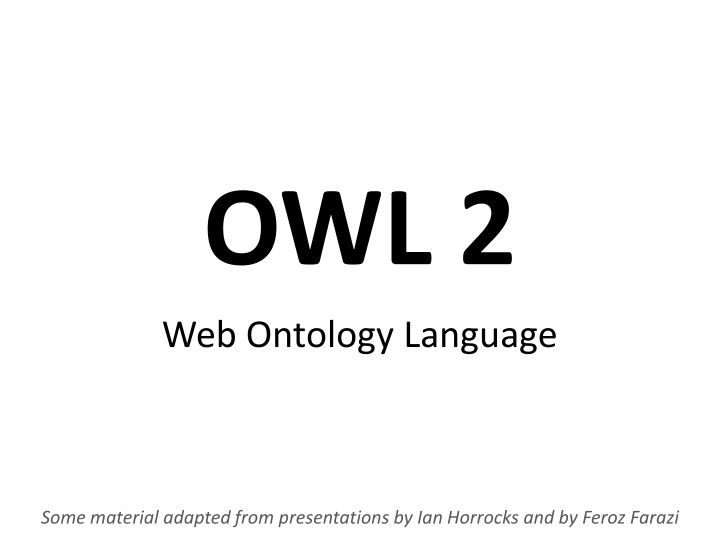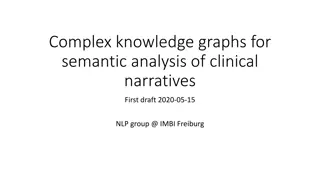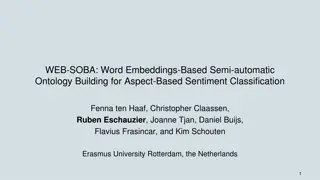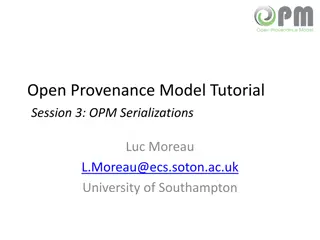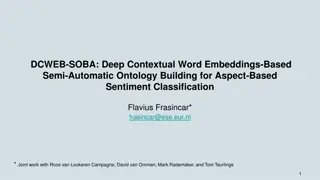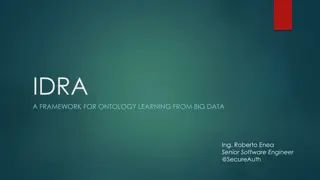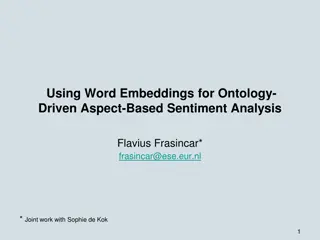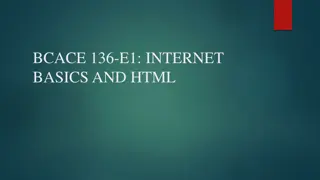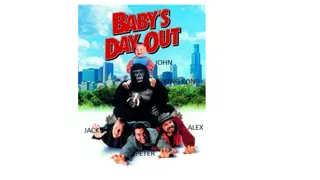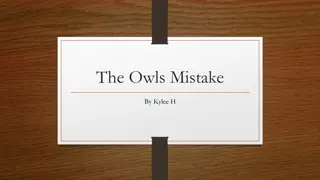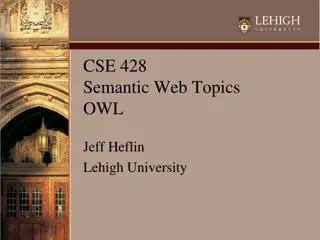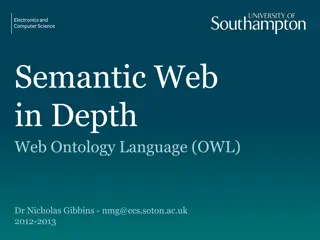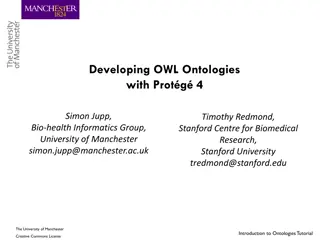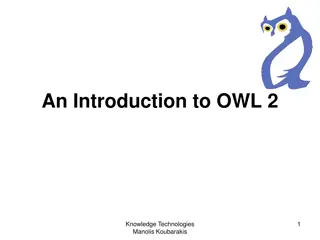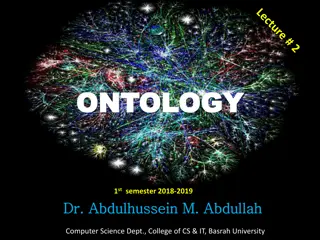Overview of OWL 2 Web Ontology Language Features
Introduction to OWL 2, its extension from OWL 1.1, and compatibility, new features based on real applications and use cases, adoption as a W3C recommendation in 2009, and the rationale behind features like syntactic sugar, new constructs, extended datatypes, and punning.
Download Presentation

Please find below an Image/Link to download the presentation.
The content on the website is provided AS IS for your information and personal use only. It may not be sold, licensed, or shared on other websites without obtaining consent from the author.If you encounter any issues during the download, it is possible that the publisher has removed the file from their server.
You are allowed to download the files provided on this website for personal or commercial use, subject to the condition that they are used lawfully. All files are the property of their respective owners.
The content on the website is provided AS IS for your information and personal use only. It may not be sold, licensed, or shared on other websites without obtaining consent from the author.
E N D
Presentation Transcript
OWL 2 Web Ontology Language Some material adapted from presentations by Ian Horrocks and by Feroz Farazi
Introduction OWL 2 extends OWL 1.1 and is backward compatible with it The new features of OWL 2 based on real applications, use cases and user experience Adopted as a W3C recommendation in December 2009 All new features were justified by use cases and examples Most OWL software supports OWL now
Features and Rationale Syntactic sugar New constructs for properties Extended datatypes Punning Extended annotations Some innovations Minor features
Syntactic Sugar OWL 2 adds features that Don t change expressiveness, semantics, complexity Makes some patterns easier to write Allowing more efficient processing in reasoners New features include: DisjointClasses DisjointUnion NegativeObjectPropertyAssertion NegativeDataPropertyAssertion
Syntactic sugar: disJointClasses It s common to want to assert that a set of classes are pairwise disjoint -No individual can be an instance of 2 of the classes in the set Faculty, staff and students are all disjoint [a owl:allDisjointClasses; owlmembers (:faculty :staff :students)] In OWL 1.1 we d have to make three assertions :faculty owl:disjointWith :staff :faculty owl:disjointWith :student :staff owl:disjointWith :staff Will be cumbersome for large sets
Syntactic sugar: disJointUnion Need for disjointUnion construct A :CarDoor is exclusively either a :FrontDoor, a :RearDoor or a :TrunkDoor and not more than one of them In OWL 2 :CarDoor a owl:disjointUnionOf (:FrontDoor :RearDoor :TrunkDoor). In OWL 1.1 :CarDoor owl:unionOf (:FrontDoor :RearDoor :TrunkDoor). :FrontDoor owl:disjointWith :ReadDoor . :FrontDoor owl:disjointWith :TrunkDoor . :RearDoor owl:disjointWith :TrunkDoor .
Syntactic sugar: disJointUnion It s common for a concept to have more than one decomposition into disjoint union sets E.g.: every person is either male or female (but not both) and also either a minor or adult (but not both) foaf:Person owl:disjointUnionOf (:MalePerson :FemalePerson); owl:disjointUnionOf (:Minor :Adult) .
Syntactic sugar: negative assertions Asserts that a property doesn t hold between two instances or between an instance and a literal NegativeObjectPropertyAssertion Barack Obama was not born in Kenya NegativeDataPropertyAssertion Barack Obama is not 60 years old Encoded using a reification style
Syntactic sugar: negative assertions @prefix dbp: <http://dbpedia.org/resource/> . @prefix dbpo: <http://dbpedia.org/ontology/> . [a owl:NegativeObjectPropertyAssertion; owl:sourceIndividual dbp:Barack_Obama ; owl:assertionProperty dbpo:born_in ; owl:targetIndividual dbp:Kenya] . [a owl:NegativeDataPropertyAssertion; owl:sourceIndividual dbp:Barack_Obama ; owl:assertionProperty dbpo:age ; owl:targetIndividual "60" ] .
Syntactic sugar: negative assertions Note that the negative assertions are about two individuals Suppose we want to say that :john has no spouse? Or to define the concept of an unmarried person? Can we use a negative assertion to do it?
Syntactic sugar: negative assertions Suppose we want to say that :john has no spouse? [a owl:NegativeObjectPropertyAssertion; owl:sourceIndividual :john ; owl:assertionProperty dbpo:spouse ; owl:targetIndividual ????????] . We can t do this with a negative assertion It requires a variable, e.g., there is no ?X such that (:john, dbpo:spouse, ?X) is true
Syntactic sugar: negative assertions The negative assertion feature is limited Can we define a concept :unmarriedPerson and assert that :john is an instance of this? We can do it this way: An unmarried person is a kind of person and a kind of thing with exactly 0 spouses
John is not married :john a :unmarriedPerson . :unmarriedPerson a Person; a [a owl:Restriction; onProperty dbpo:spouse; owl:cardinality 0 ] .
New property Features Self restriction Qualified cardinality restriction Object properties Disjoint properties Property chain Keys
Self restriction Classes of objects that are related to themselves by a given property E.g., the class of processes that regulate themselves It is also called local reflexivity E.g., Auto-regulating processes regulate themselves Narcissists are things who love themselves :Narcissist owl:equivalentClass [a owl:Restriction; owl:onProperty :loves; owl:hasSelf "true"^^xsd:boolean] .
Qualified cardinality restrictions Qualifies the instances to be counted Six varieties: {Data|Object}{Min|Exact|Max} Type Examples People with exactly 3 children who are girls People with at least 3 names Each individual has at most 1 SSN Pizzas with exactly four toppings all of which are cheeses
Qualified cardinality restrictions Done via new properties with domain owl:Re- striction, namely {min|max|}QualifiedCardinality andonClass Example: people with exactly three children who are girls [a owl:restriction; owl:onProperty :has_child; owl:onClass [owl:subClassOf :FemalePerson; owl:subClassOf :Minor]. QualifiedCardinality 3 .
Object properties ReflexiveObjectProperty Globally reflexive Everything is part of itself IrreflexiveObjectProperty Nothing can be a proper part of itself AsymmetricObjectProperty If x is proper part of y, then the opposite does not hold
Disjoint properties E.g., you can t be both the parent of and child of the same person DisjointObjectProperties (for object properties) E.g., :hasParent owl:propertyDisjointWith :hasChild DisjointDataProperties (for data properties) E.g., :startTime owl:disjointWith :endTime AllDisjointProperties for pairwise disjointness [a owl:AlldisjointProperties ; owl:members ( :hasSon :hasDaughter :hasParent ) ] .
A Dissertation Committee Here is a relevant real-world example. A dissertation committee has a candidate who must be a student and five members all of whom must be faculty. One member must be the advisor, another can be a co-advisor and two must be readers. The readers can not serve as advisor or co-advisor. How can we model it in OWL?
A Dissertation Committee A dissertation committee has a candidate who must be a student and five members all of whom must be faculty. One member must be the advisor, another can be a co-advisor and two must be readers. The readers can not serve as advisor or co- advisor. Define a DissertationCommittee class Define properties it can have along with appropriate constraints
A Dissertation Committee :DC a owl:class; [a owl:Restriction; owl:onProperty :co-advisor; owl:maxCardinality 1 ] . :candidate a owl:FunctionalProperty; rdfs:domain :DC; rdfs:range student. :advisor a owl:FunctionalProperty; rdfs:domain :DC; rdfs:range faculty. :co-advisor owl:ObjectProperty; rdfs:domain :DC; rdfs:range faculty, owl:propertyDisjointWith :advisor .
Property chain inclusion Properties can be defined as a composition of other properties The brother of your parent is your uncle :uncle owl:propertyChainAxion (:parent :brother) . Your parent s sister s spouse is your uncle :uncle owl:propertyChainAxion (:parent :sister :spouse) .
Keys Individuals can be identified uniquely Identification can be done using A data or object property (equivalent to inverse functional) A set of properties Examples foaf:Person owl:hasKey (foaf:mbox), (:homePhone :foaf:name).
Extended datatypes Extra datatypes Examples: owl:real, owl:rational, xsd:pattern Datatype restrictions Range of datatypes For example, a teenager has age between 13 and 18
Extended datatypes Data range combinations Intersection of DataIntersectionOf( xsd:nonNegativeInteger xsd:nonPositiveInteger ) Union of DataUnionOf( xsd:string xsd:integer ) Complement of data range DataComplementOf( xsd:positiveInteger )
An example :Teenager a [owl:Restriction ; owl:onProperty :hasAge ; owl:someValuesFrom _:y .] _:y a rdfs:Datatype ; owl:onDatatype xsd:integer ; owl:withRestrictions ( _:z1 _:z2 ) . _:z1 xsd:minInclusive "13"^^xsd:integer . _:z2 xsd:maxInclusive "19"^^xsd:integer .
Punning OWL 1 DLthings can t be both a class and instance E.g., :SnowLeopard can t be both a subclass of :Feline and an instance of :EndangeredSpecies OWL 2 DL offers better support for meta- modeling via punning A URI denoting an owl thing can have two distinct views, e.g., as a class and as an instance The one intended is determined by its use A pun is often defined as a joke that exploits the fact that a word has two different senses or meanings
Punning Restrictions Classes and object properties also can have the same name For example, :mother can be both a property and a class of people But classes and datatype properties can not have the same name Also datatype properties and object properties can not have the same name
Punning Example @prefix foaf: <http://xmlns.com/foaf/0.1/> . @prefix owl: <http://www.w3.org/2002/07/owl#> . @prefix rdfs: <http://www.w3.org/2000/01/rdf-schema#>. foaf:Person a owl:Class. :Woman a owl:Class. :Parent a owl:Class. :mother a owl:ObjectProperty; rdfs:domain foaf:Person; rdfs:range foaf:Person . :mother a owl:Class; owl:intersectionOf (:Woman :Parent). validate via http://owl.cs.manchester.ac.uk/validator/
Annotations In OWL annotations comprise information that carries no official meaning Some properties in OWL 1 are annotation properties, e.g., owl:comment, rdf:label and rdf:seeAlso OWL 1 allowed RDF reification as a way to say things about triples, again w/o official meaning [a rdf:Statement; rdf:subject :Barack_Obama; rdf:predicate dbpo:born_in; rdf:object :Kenya; :certainty 0.01 ].
Annotations OWL 2 has native support for annotations, including Annotations on owl axioms (i.e., triples) Annotations on entities (e.g., a Class) Annotations on annotations The mechanism is again reification
Annotations :Man rdfs:subClassOf :Person . _:x rdf:type owl:Axiom ; owl:subject :Man ; owl:predicate rdfs:subClassOf ; owl:object :Person ; :probability 0.99"^^xsd:integer; rdfs:label Every man is a person. .
Inverse object properties Some object property can be inverse of another property For example, partOf and hasPart The ObjectInverseOf( :partOf ) expression represents the inverse property of :part of This makes writing ontologies easier by avoiding the need to name an inverse
OWL Sub-languages OWL 1 had sub-languages: OWL FULL, OWL DL and OWL Lite OWL FULL is undecidable OWL DL is worst case highly intractable Even OWL Lite turned out to be not very tractable (EXPTIME-complete) OWL 2 introduced three sub-languages, called profiles, designed for different use cases
OWL 2 Profiles OWL 2 defines three different tractable profiles: EL: polynomial time reasoning for schema and data Useful for ontologies with large conceptual part QL: fast (logspace) query answering using RDBMs via SQL Useful for large datasets already stored in RDBs RL: fast (polynomial) query answering using rule- extended DBs Useful for large datasets stored as RDF triples
OWL Profiles Profiles considered Useful computational properties, e.g., reasoning complexity Implementation possibilities, e.g., using RDBs There are three profiles OWL 2 EL OWL 2 QL OWL 2 RL
OWL 2 EL A (near maximal) fragment of OWL 2 such that Satisfiability checking is in PTime (PTime-Complete) Data complexity of query answering is PTime-Complete Based on EL family of description logics Existential (someValuesFrom) + conjunction It does not allow disjunction and universal restrictions Saturation isan efficient reasoning technique It can capture the expressive power used by many large-scale ontologies, e.g., SNOMED CT
Basic Saturation-based Technique Normalise ontology axioms to standard form: Saturate using inference rules: Extension to Horn fragment requires (many) more rules Saturation is a general reasoning technique in which you first compute the deductive closure of a given set of rules and add the results to the KB. Then run your prover.
Saturation-based Technique Performance with large bio-medical ontologies Galen and Snomed are large ontologies of medical terms; both have OWL versions. NCI is a vocabulary of cancer-related terms. GO is the gene ontology.
OWL 2 QL The QL acronym reflects its relation to the standard relational Query Language It does not allow existential and universal restrictions to a class expression or a data range enable a tight integration with RDBMSs reasoners can be implemented on top of standard relational databases Can answer complex queries (in particular, unions of conjunctive queries) over the instance level (ABox) of a DL knowledge base
OWL 2 QL We can exploit query rewriting based reasoning technique Computationally optimal Data storage and query evaluation can be delegated to standard RDBMS Can be extended to more expressive languages (beyond AC0) by delegating query answering to a Datalog engine
What is Datalog? Truly declarative logic programming language that s a subset of Prolog Just rules and facts No data structures, cut Rule ordering unimportant Used as a query language for deductive databases Queries on finite sets sets guaranteed to terminate parent(bill,mary). parent(mary,john). ancestor(X,Y) :- parent(X,Y). ancestor(X,Y) :- parent(X,Z),ancestor(Z,Y).
Query Rewriting Technique (basics) Given ontology O and query Q, use O to rewrite Q as Q0 such that, for any set of ground facts A: ans(Q, O, A) = ans(Q0, ;, A) Resolution based query rewriting Clausify ontology axioms Saturate (clausified) ontology and query using resolution Prune redundant query clauses
Query Rewriting Technique (basics) Example: Q(x) is our query: Who treats people who are patients?
Query Rewriting Technique (basics) Example: Translate the DL expressions into rules f(x) is a Skolem individual If you are a doctor then you treat someone and that someone is a patient
Query Rewriting Technique (basics) Example: For each rule in the rules version of the KB we want to enhance the query, so that we need not use the rule in the KB.
Query Rewriting Technique (basics) Example: Doctor(X) implies treats(x, f(x)) so we can replace it Must unify f(x) with y, so end up with the second way of satisfying our query Q(x)
Query Rewriting Technique (basics) Example:
Query Rewriting Technique (basics) Example: Applying the KB second rule to the 1st query rule gives us another way to solve the Q(x)
